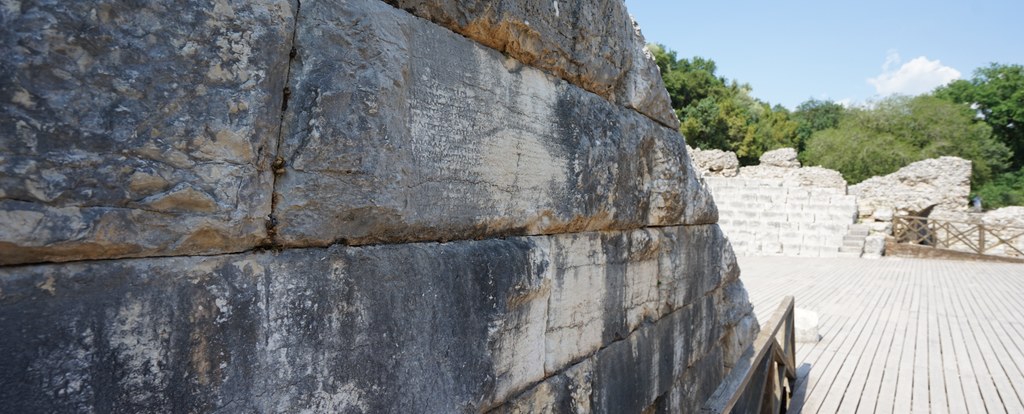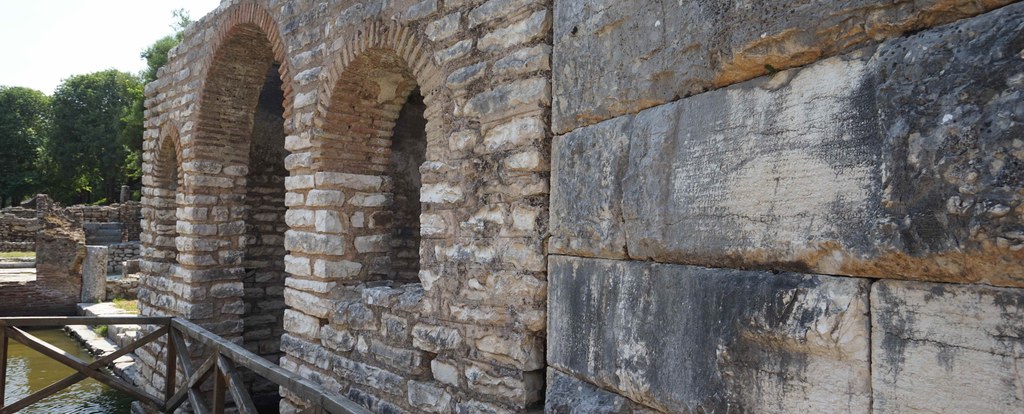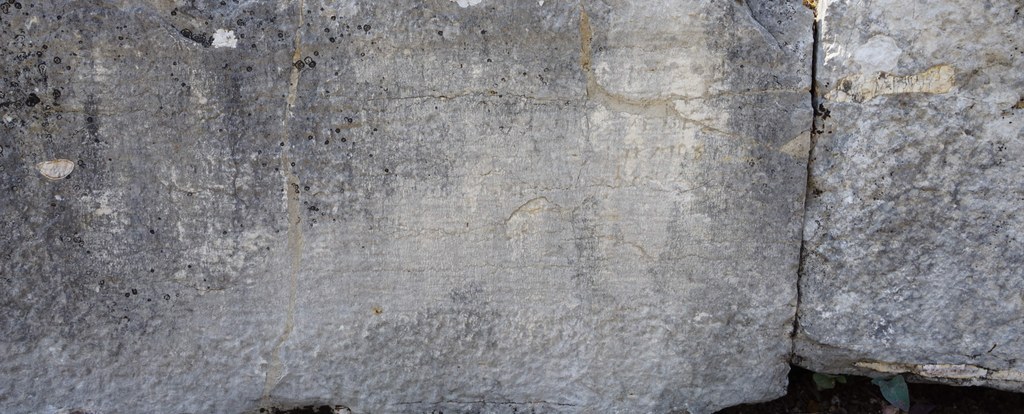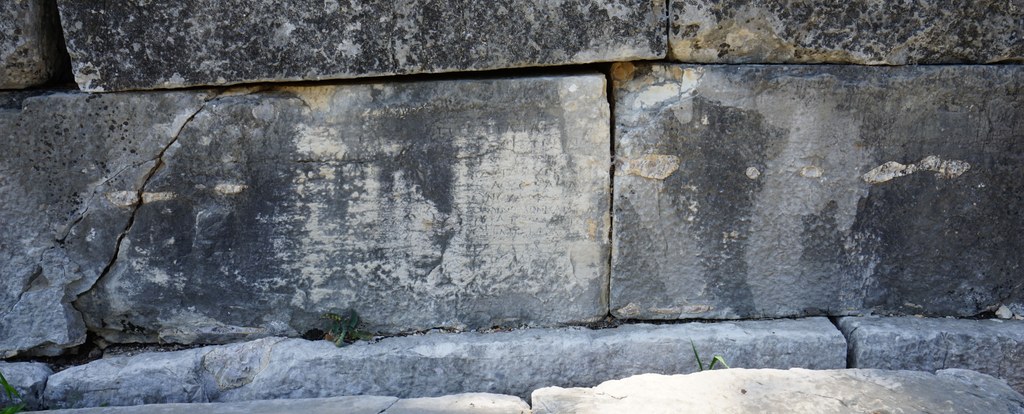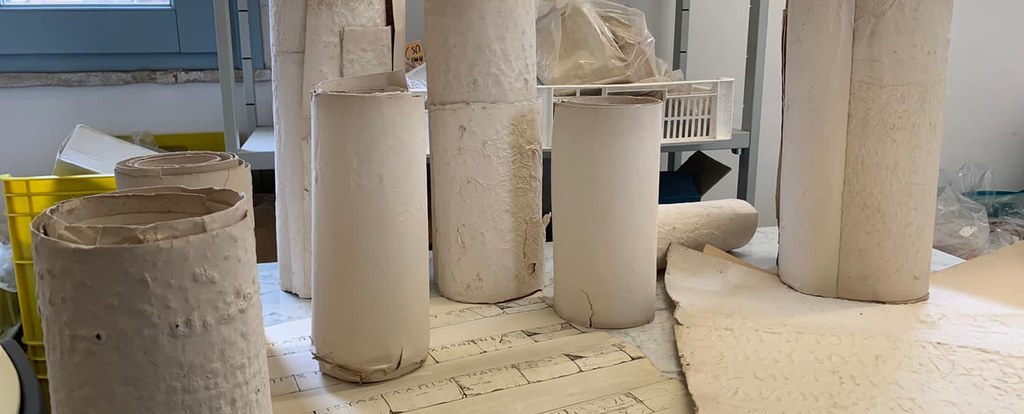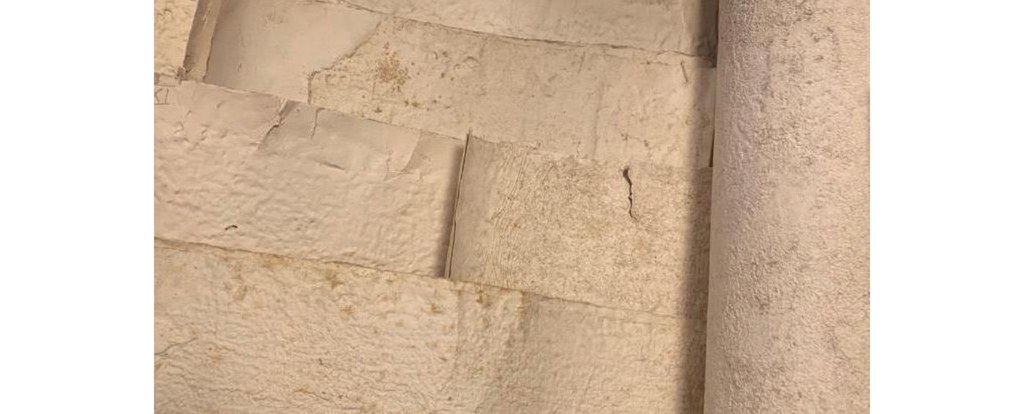The paper squeezes of the inscriptions in the Butrint Theatre
New evidence of an ancient discovery sheds new light on Butrint's history and on the archaeological research in the city.
The ancient discovery: the inscriptions of the Theatre
The Sanctuary of Asclepius can be considered one of the landmarks of Butrint. The whole complex, first built between the end of the 4th and the beginning of the 3rd century BC and then expanded during the Roman domination, really stands out in the layout of the city. Its well-preserved Theatre along with the nearby Shrine and the numerous surrounding structures linked to the cult of Asclepius as well, even the hardly visible Temple on the upper terrace, really give the idea of how vital and industrious this centre was. The centrality of Butrint, one of the most important city in Chaonia for most of Antiquity, is easily reconstructed also thanks to the numerous inscriptions found in the site.
The inscriptions were visibile, carved in the white limestone of the diazoma wall, since the beginning of the excavation of the Theatre in 1928. Luigi Maria Ugolini, the leader of the first Italian Archaeological Mission in Butrint, called Luigi Morricone in 1933 to become part of his team with the precise task of studying the inscriptions found during the excavation, since it was clear how important they were for understanding the history of the city. A difficult job indeed, because at that time there was much less known not only about Butrint but also about the history of Epirus, more generally speaking, so it was quite demanding trying to reconstruct and face all the philological and historical problems the inscriptions unleashed.
The epigraphs of the Theatre were divided into three main groups by Morricone himself. There is the commemorative inscription, which celebrates the construction of the Theatre by the prostates of the Chaones and the priest of Asclepius using the revenues derived from the cult of the god. There are the 29 inscriptions on the analemma of the western parodos, 27 of which are manumission inscriptions for the liberation of slaves, covering a period of almost 30 years. Finally, there are the 14 inscriptions on the diazoma, which refer to acts of manumissions as well, even though these are more specific in mentioning, in a span of almost one decade, the time of the year and the witnesses participating in the ceremony. These are subsequent to the inscription of the parodos, in fact they refer to the strategos and the prostates ton Prasaibon. The manumissions are dated between 3rd and 2nd century BC. They refer also to the presence of the prostates of the Chaones and, most of the times, the priest of Asclepius, who was the caretaker and the guarantor for the manumissions. The names of both the prostates and the priests are also used as reference for the dating of the inscriptions. Other contemporary manumissions can also be found on the so-called Tower of Inscriptions discovered by Dhimosten Budina in 1977, located about 150 m from the Theatre and built using reused blocks, probably coming from the Sanctuary of Asclepius as well.
As Giovanni Pugliese Carratelli would later say, Morricone’s desire to fill all the uncertainties related to the background of the inscriptions and his natural attitude toward precision, along with his premature death, actually prevented him from publishing his work. He was the first to study this epigraphic material, but he was preceeded in the publication by the volume written by Budina in collaboration with Bozhori in 1966 about the inscription of the parodos, followed by J. and L. Robert Bulletin in 1967. Pierre Cabanes in 1974 submitted a new and more correct version of the 1966 publication. Also Cabanes, in the following years, proceeded in publishing some of the inscriptions of the diazoma, while in 1977 more manumission inscriptions were found in the city. It was only in 1986 that Pugliese Carratelli revisioned all the material gathered by Morricone and finally decided to print it and fulfil all the efforts began almost 50 years before.
New evidences: the paper squeezes of the inscriptions
As years passed by, the study of these epigraphs has continued. The value of the information they carry engraved on their surface is fundamental for understanding the functioning of social life, as well as religious and political institutions, a cross-section of a site which still has many questions to answer. The Butrint Project has always reserved a special attention toward the Sanctuary of Asclepius. The very first activities carried on site in 2015 by Enrico Giorgi and Sandro De Maria were, in fact, the topographical survey and the analysis of the state of conservation of the temple of Asclepius, later extended to the whole sanctuary. More recently, two new lines of research have been launched in order to better understand the complex of the sanctuary and, by so doing, the Hellenistic and Roman phases of the city. On the one hand, a re-examination of the materials found in the favissa of the shrine of Asclepius and, on the other hand, a collaboration with the epigraphists of the University of Macerata for a new analysis of the inscriptions.
The restrictions due to the Coronavirus pandemic meant a temporary interruption of massive field work for 2020. However, to our great surprise, the remote studies we had to adapt to still brought with them a great rediscovery. The epigraphists of the University of Macerata, coordinated by Simona Antolini, found in their warehouse over sixty squeezes of the inscriptions of the Butrint Theatre made during the excavation of the 1930s. It is still difficult to reconstruct the journey of these casts. The only certainty is that Antonino di Vita, former director of the Italian Archaeological School in Athens, gave them to Gianfranco Paci, who later brought everything to Italy in the 1980s for studying purposes. These delicate paper squeezes in absorbent filter paper were made to obtain three-dimensional reproductions of the letters engraved on the stone. Their value is remarkable not only because they show the state of conservation of the original inscriptions in the exact moment of the discovery, but also because they represent a testimony in the field of the history of archaeology, which is equally interesting and relevant.
These squeezes have open a whole new set of possibilities. We can only make assumptions on why they arrived in Athens in the first place, and we don’t know yet if Pugliese Carratelli consulted them during his revision of Morricone’s work before publishing. However, researchers from both the University of Bologna and University of Macerata are already working for their restoration and 3D digital documentation. From what is visible in the present conditions, it seems plausible that these casts belong to the Theatre inscriptions, which would be a really useful occasion to read them better than we can do today in place, due to the deterioration of the stone. The Team is currently considering how to valorise in the best way possibile this discovery, both from the point of view of the archaeological and epigraphical history of Butrint, but also valuing how to include them in the mechanism of public history and archaeology for the fruition of the ancient city by the public.
